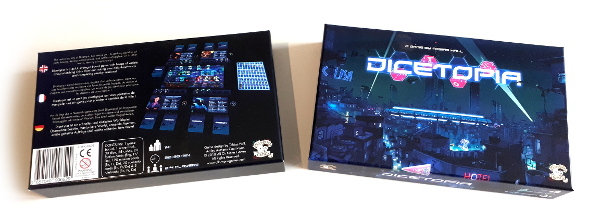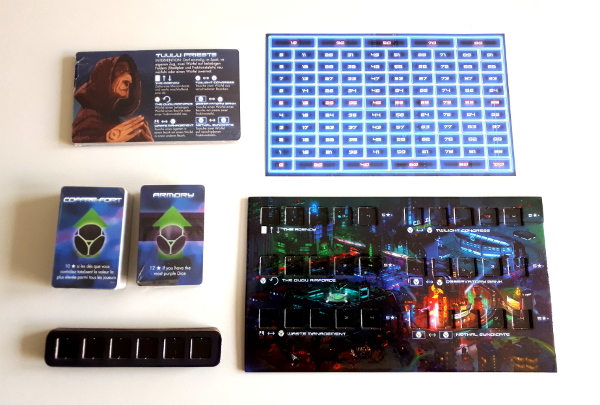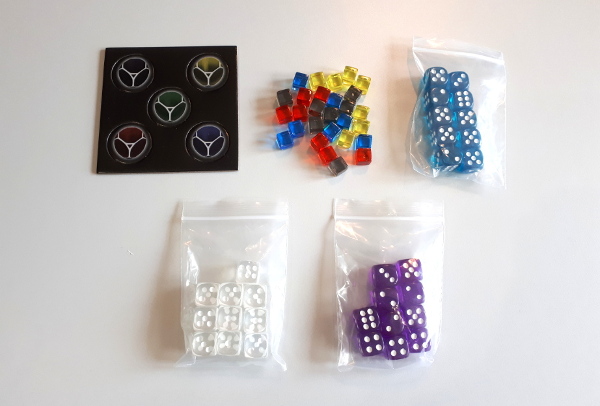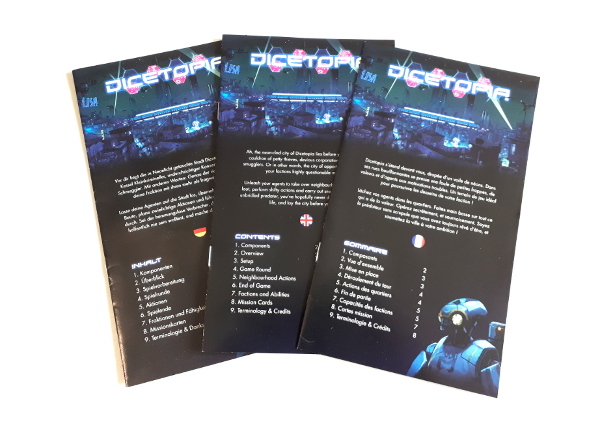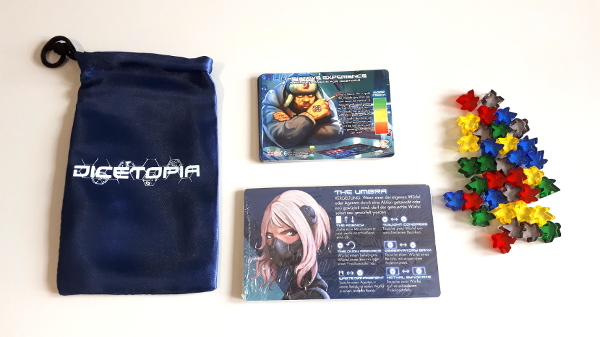Dicetopia unboxing
Featured game
DicetopiaNumber of players: 2–4
Typical game length: 20–30 mins
Price: €25 (base game) / €40 (with extras)
Official link BGG link
Earlier this year I backed Dicetopia by All Or None Games on Kickstarter. I don’t recall who recommended it to me, but when I saw the Kickstarter page the game ticked a lot of boxes for me. The dystopian cyberpunk inspired setting (though the cyberpunk influence is my own interpretation) and the dice swapping/manipulation mechanic combined with secret objectives definitely caught my interest. It helped that the dice and worker cubes were all translucent and looked great combined with the art style of the game.
Dicetopia is a quick strategic board game for 2-4 players with a playtime of 20-30 minutes. The game introduces a fresh mix of area control, dice manipulation, worker placement and secret objectives. On players turn they will send out one of their agents to a neighbourhood in the city. This single move will determine the resource they’ll collect, their control of that neighbourhood, and what action they’ll perform.
The finished game was delivered recently, so let’s take a look at what you get in the box! Apologies for the quality of the photos, there are disadvantages to not having a proper lighting rig.
Base game
The box measures 22 x 13.5 x 3.5cm. It is nicely solid and has a tight fit between base and lid; tight enough to make it hard to open in fact. It definitely won’t fall open and throw components all over the floor. It’s smooth with a slightly glossy finish and the artwork is printed at a high quality. Exactly what you’d expect from a game box.
Moving on to the components we have the game boards and cards. The city board and the faction boards (bottom of the image above) are dual-layer boards with the top layer having cut-outs to accommodate dice or the smaller agent cubes. I have no concerns about the rigidity of these boards. The two layers are obvious when looked at side-on, but that is a minor aesthetic detail. One issue I had is that the mission board is very closely sized to the box length-wise and was hard to get out. This obviously doesn’t impact the game functionally, but does potentially result in a minute or two of trying different ways to extract it.
The mission and scenario cards (center left above) are made of relatively thin cardstock, but their small size means that they still feel stiff. If you wish to sleeve these cards All Or None Games recommended Mini European Board Game sleeves from Fantasy Flight Supply, which measure 44 x 68mm. In my opinion these sleeves are a few mm too tall for the cards, but slightly oversize is better than slightly undersize. You get three sets of mission cards (one each in English, French, and German) and two sets of scenario cards (one in English and one with French on one side and German on the other).
The faction cards (top left) are made of the same cardstock as the mission cards but are larger and so are more flexible and don’t feel quite as strong as I would like. You’ll likely want to sleeve these to provide some extra robustness if they’re going to be handled a lot. For these cards All Or None Games recommended Tarot Card sleeves from Fantasy Flight Supply, which measure 70 x 120mm. The cards fit into these sleeves nicely. You get two sets of these. One is in English only, while the other has French on one side and German on the other.
Finally the score track (top right). This feels like it’s made from marginally thinner card than the faction and mission cards. It’s definitely more flexible. In my opinion this could do with being thicker, as it is a game board rather than a card.
Now we move on to the dice, markers, and tokens. Both the dice and the agent cubes are translucent and brightly coloured, which makes them stand out clearly on the city and faction boards and fits the game’s aesthetic well. The ability tokens are easily punched out and feel very solid—bending them would require some effort.
Finally we reach the rulebooks. I say “rulebooks”, plural, because you get one for each of the languages supported by the game: English, French, and German. These are largely what you would expect, being made from slightly glossy paper with a saddle staple binding. They’re relatively short and get straight to the point.
Extras
In addition to the base game the Kickstarter package included some stretch goals in the form of a dice bag and additional factions. There were also a couple of add-ons in the form of agent meeples and a solo expansion.
A branded dice bag is always a nice accompaniment to a game like this. The Dicetopia one is in a dark blue colour with a white monochrome version of the Dicetopia logo that I don’t think I’ve seen elsewhere. I have to say that I like how this version of the logo looks.
The faction cards are on the same cardstock as the ones in the base game, so there’s not much to say there. As with the ones in the base game you get two sets, with English on one and French and German on the other.
The solo expansion consists of 9 poker size cards that provide you with a single “AI” opponent to play against. I only received the English version of these cards, but I believe that French and German are available. I assume its status as an add-on rather than a core game item weighed on the decision to not provide all three languages together. These cards use the same cardstock as the other cards in the game and so sit between the mission and faction cards in how stiff they feel. I’d recommend sleeving them.
Finally, the agent meeples replace the agent cubes provided with the base game. As with the cubes they are made of translucent plastic, but they come in five colour rather than four. The additional green meeples allow five player games with a promised future print-and-play location.
Wrapping up
Overall I’d say the game components are of a good quality, with a few small areas for improvement.
Some of the cards would benefit from slightly thicker cardstock, depending on how roughly they will be handled. The score track would definitely benefit from this due to its size. If I had to choose one change to make to the components then it would be to change the score track into more of a game board than a game card.
The city board and the translucent dice and cubes/meeples are the highlights of the components for me. The support for multiple languages is also a good thing if you are more fluent in French or German than the default English that most games come in.
As a final note, with a bit of careful laying out of components the game box will hold all of the base game and extra components I’ve shown here. This wouldn’t be the case if you sleeve the cards though.
